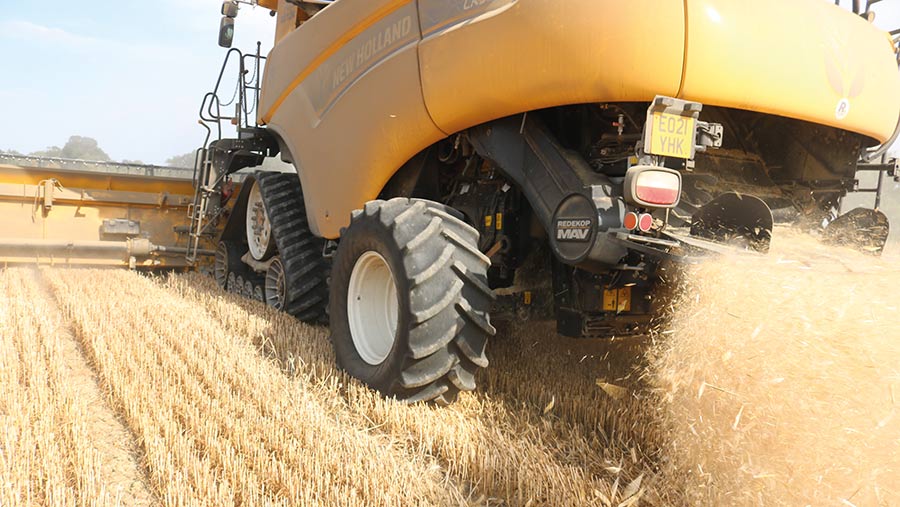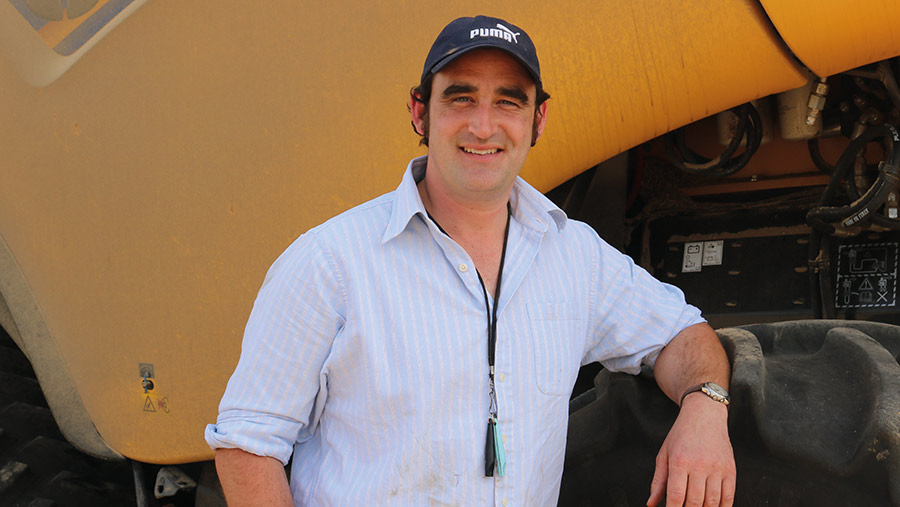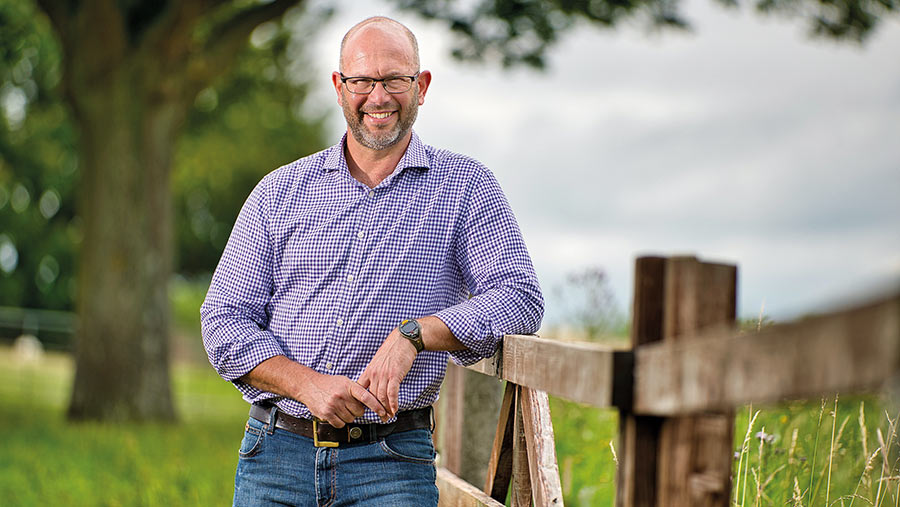Farmers reveal results of combine weed seed destroyer trial
 © Bofin
© Bofin A group of UK farmers has trialled a Canadian weed seed control unit which uses a non-chemical approach to destroy up to 98% of harvestable weeds.
The Redekop seed control unit (SCU) simply attaches to the rear of a combine. In a single pass it mills chaff to a fine dust and destroys weed seeds such as meadow brome and ryegrass.
See also: How farmer trial will test Canadian combine weed seed destroyer
Redekop co-owner and president Trevor Thiessen explains that the project aims to work closely with farmers to tailor the technology.
“We see this technology as a key part of weed management,” he says. “The SCU is not a sole replacement, but another tool for farmers and operators to use to get on top of weeds.”
Co-ordinated by the British On-Farm Innovation Network (Bofin), the trial saw three farmers use the device for harvest 2022, while independent crop research group Niab monitored results.
We caught up with the farmers and experts to find out how they got on.
Ted Holmes, Velcourt farm manager, Warwickshire

Ted Holmes © Bofin
Resistant ryegrass is the number one weed threat for Velcourt farm manager Ted Holmes, so he was keen to trial the SCU on his New Holland CR9.90.
The unit ran all summer. When the SCU was engaged in a winter barley crop, there was a 60% reduction of Italian ryegrass in the following crop of oilseed rape.
In one area, weed seedlings fell from 46/sq m without the SCU to 25/sq m with the unit engaged.
In spring barley, a similar pattern was identified, but with a 44% reduction.
However, a pass of the subsoiler before the weed assessment is thought to have introduced a greater number of weed seeds, limiting the effect of the SCU.
Seasonal effects on seed viability also had an impact, with more ryegrass shed before harvest. Further testing revealed that a large proportion of the seed was unviable due to the hot, dry conditions.
Mr Holmes says the unit was easy to use, but there were a few teething issues.
“Due to the design of the SCU and straw chopper unit, we had to remove the New Holland’s positive straw discharge belt,” he explains.
“This gave us headaches in certain straw swathing situations as we struggled to get straw out the back of the combine. After several conversations with Redekop we have a solution for harvest 2023.”
Mr Holmes also noted a 10-12% increase in fuel consumption when the SCU was engaged due to greater engine load.
When chopping straw and running the seed unit in a 9t/ha crop of Skyfall milling wheat, fuel use ranged was 18-21 litres/ha.
Similarly, when swathing the straw in an 11t/ha Extase feed wheat, fuel use was 17-20 litres/ha, which was 10% higher than with the unit disengaged.
Mr Holmes believes the fuel usage in this crop was similar to the milling wheat due to a much bigger crop of straw going through the combine, as well as the design of the unit.
“Even when you are not chopping straw you are still running the unit itself, obviously adding to fuel consumption,” he says.
“We certainly learned a lot this summer and I’m looking forward to using the SCU again, as I believe it can bring big integrated pest management benefits. First thoughts: A huge thumbs-up from us.”
Adam Driver, Driver Farms, Suffolk

Adam Driver © Bofin
Adam Driver’s Lexion 8800 was the first Claas combine in Europe to be fitted with the SCU, with the aim of reducing blackgrass and preventing brome from spiralling.
After the first season using the SCU, volunteer wheat control in winter barley also proved effective. “The unit really helped minimise the green bridge when growing cereal-to-cereal crops,” he says.
Niab weed scientist Will Smith measured potential weed seed available to the combine at harvest and found that 54% of blackgrass seed was retained in the ear of winter wheats.
“We would usually expect this to be 10-30%, so there was more seed available to the SCU than originally thought,” he says.
“Hot and dry harvest conditions must be considered, but if weather like this continues, it opens the possibility of the SCU targeting blackgrass.”
When investigating weed populations on Mr Driver’s farm, a visible shift was identified in the placement of weed species behind the combine.
A combination of no-till and controlled-traffic farming for the past eight years is thought to have concentrated weeds – most notably meadow brome, but also blackgrass – in this area.
“This reinforces that a proportion of blackgrass seed is going through the combine which can be targeted by the mill,” explains Mr Smith.
One issue Mr Driver experienced was that he was unable to disengage the seed unit on his Class combine.
Redekop plans to make the simple manual clutch that disengages the unit available on Claas combines ahead of next season.
Jake Freestone, Overbury Enterprises, Gloucestershire

Jake Freestone © Bofin
Gloucestershire farm manager Jake Freestone connected the SCU to two different John Deere combines this harvest, and hopes to reduce weed seed burdens and dependency on herbicides.
He first installed the device to his S685i combine before switching to his new S790i and says installation and removal were relatively straightforward.
However, the rear axle had to be widened to accommodate the SCU on the new machine. The unit fits below the chopper, with its drive to the side, so this would otherwise interfere with the rear-wheel steering.
“Pushing the width out to 3.8m made it more difficult to get through gateways and narrow roads,” says Mr Freestone.
Engaging the SCU was quick and simple. “You just pull out a clutch wheel, but there is a series of flaps you have to move to divert the chaff stream, which requires cleaning,” he says.
“The SCU slowed us down a little on the hills, from 4.2kph to 3.7kph. You can tell it’s working a little harder.”
Two fields of Extase wheat were cut on 5 August at 13% moisture.
With the SCU disengaged, the first field yielded 9.6t/ha and used 21.2 litres/ha of fuel. With the SCU engaged in a slightly higher-yielding crop of 9.9t/ha, fuel use increased by 2.3 litres/ha to 23.5 litres/ha.
Niab’s Will Smith notes that the first year’s blackgrass results in winter wheat were inconclusive, with no net change in the population.
“Generally speaking, blackgrass has a much lower density, high seed shed and low seed retention, so this is to be expected,” he says. “Whether the SCU was engaged or disengaged had very little difference.”
Although meadow brome was present in the spring barley, the density was low so that results were, again, inclusive. Further trials will assess weed populations in both spring and winter barley next year.
Mr Freestone says he was not expecting the SCU to make a sudden difference, and that it will take a couple of years before effects will be visible.
Used in conjunction with other non-chemical controls, he believes it can be a useful tool.
What is Bofin?
The British On-Farm Innovation Network is a network of farmers who carry out their own on-farm trials and share the results, seeking a scientifically robust way to improve farm practice.
For more details, visit the website bofin.org.uk

